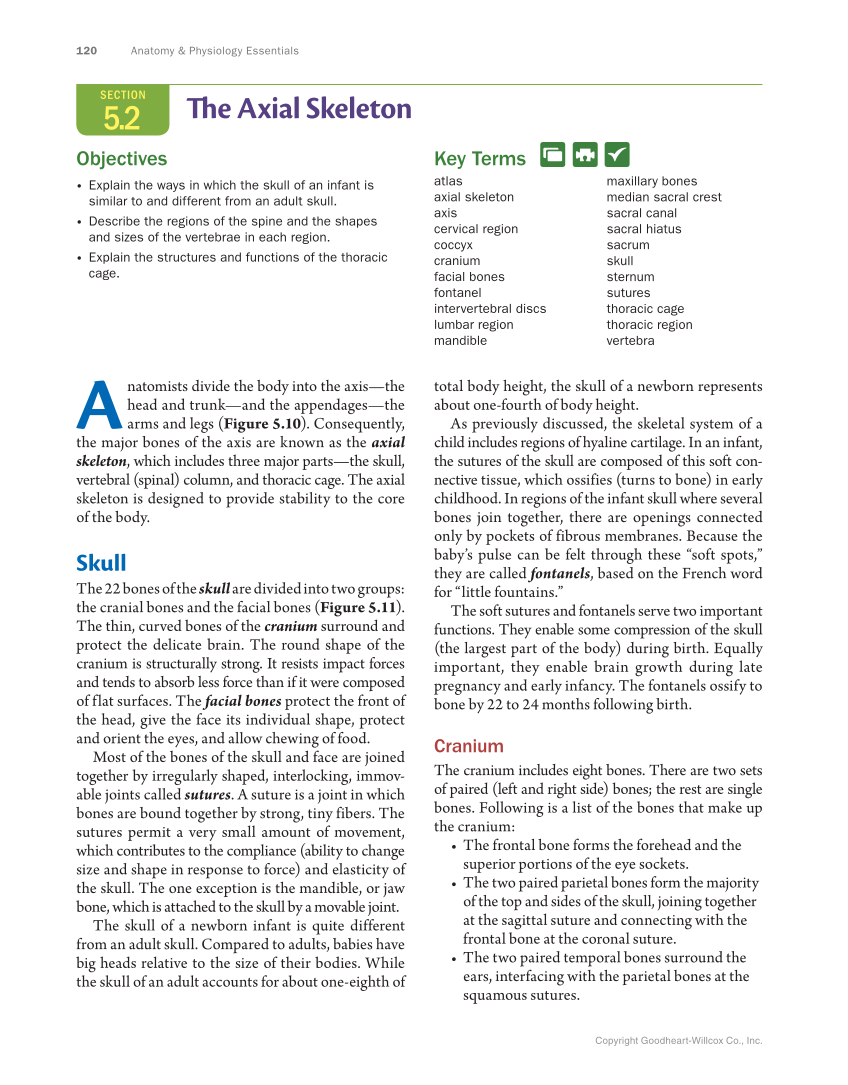120 Anatomy & Physiology Essentials Copyright Goodheart-Willcox Co., Inc. total body height, the skull of a newborn represents about one-fourth of body height. As previously discussed, the skeletal system of a child includes regions of hyaline cartilage. In an infant, the sutures of the skull are composed of this soft con- nective tissue, which ossifies (turns to bone) in early childhood. In regions of the infant skull where several bones join together, there are openings connected only by pockets of fibrous membranes. Because the baby’s pulse can be felt through these “soft spots,” they are called fontanels, based on the French word for “little fountains.” The soft sutures and fontanels serve two important functions. They enable some compression of the skull (the largest part of the body) during birth. Equally important, they enable brain growth during late pregnancy and early infancy. The fontanels ossify to bone by 22 to 24 months following birth. Cranium The cranium includes eight bones. There are two sets of paired (left and right side) bones the rest are single bones. Following is a list of the bones that make up the cranium: · The frontal bone forms the forehead and the superior portions of the eye sockets. · The two paired parietal bones form the majority of the top and sides of the skull, joining together at the sagittal suture and connecting with the frontal bone at the coronal suture. · The two paired temporal bones surround the ears, interfacing with the parietal bones at the squamous sutures. A natomists divide the body into the axis—the head and trunk—and the appendages—the arms and legs (Figure 5.10). Consequently, the major bones of the axis are known as the axial skeleton, which includes three major parts—the skull, vertebral (spinal) column, and thoracic cage. The axial skeleton is designed to provide stability to the core of the body. Skull The 22 bones of the skull are divided into two groups: the cranial bones and the facial bones (Figure 5.11). The thin, curved bones of the cranium surround and protect the delicate brain. The round shape of the cranium is structurally strong. It resists impact forces and tends to absorb less force than if it were composed of flat surfaces. The facial bones protect the front of the head, give the face its individual shape, protect and orient the eyes, and allow chewing of food. Most of the bones of the skull and face are joined together by irregularly shaped, interlocking, immov- able joints called sutures. A suture is a joint in which bones are bound together by strong, tiny fibers. The sutures permit a very small amount of movement, which contributes to the compliance (ability to change size and shape in response to force) and elasticity of the skull. The one exception is the mandible, or jaw bone, which is attached to the skull by a movable joint. The skull of a newborn infant is quite different from an adult skull. Compared to adults, babies have big heads relative to the size of their bodies. While the skull of an adult accounts for about one-eighth of SECTION 5.2 The Axial Skeleton Objectives · Explain the ways in which the skull of an infant is similar to and different from an adult skull. · Describe the regions of the spine and the shapes and sizes of the vertebrae in each region. · Explain the structures and functions of the thoracic cage. Key Terms atlas axial skeleton axis cervical region coccyx cranium facial bones fontanel intervertebral discs lumbar region mandible maxillary bones median sacral crest sacral canal sacral hiatus sacrum skull sternum sutures thoracic cage thoracic region vertebra Ch05.indd 120 4/29/2019 11:17:14 AM
